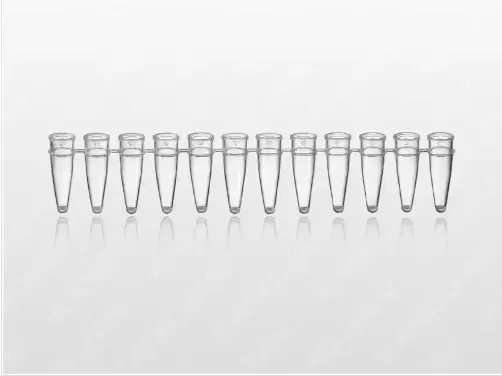Polymerase Chain Reaction (PCR) is an essential technique in molecular biology, enabling the amplification of DNA for research, diagnostics, and forensic applications. One often overlooked but critical component of successful PCR experiments is the PCR transparent reaction tube. These small yet sophisticated tools ensure the accuracy, reproducibility, and efficiency of PCR by facilitating optimal thermal conductivity, precise optical measurements, and sample visibility. In this article, Kangjian will explore the key features of PCR transparent reaction tubes in enhancing experimental outcomes.
What Is a PCR Transparent Reaction Tube?

A PCR transparent reaction tube is a specialized microtube designed for use in PCR instruments. These tubes are crafted from high-quality, optically clear materials, typically polypropylene, to ensure superior transparency and thermal stability. They are designed to withstand the high temperatures and rapid thermal cycling conditions characteristic of PCR protocols. These tubes are integral to quantitative PCR (qPCR) and traditional endpoint PCR, as they allow the detection and measurement of fluorescence signals during amplification cycles. Their optical clarity ensures that no light scattering or absorption interferes with the detection process, a crucial factor in accurate qPCR readings.
Key Features of PCR Transparent Reaction Tubes
The superior performance of PCR transparent reaction tubes lies in their carefully engineered features, each of which plays a crucial role in achieving reliable and accurate results.
1. Optical Clarity for Real-Time Fluorescence Detection
The transparent walls of PCR reaction tubes are essential for qPCR, where real-time fluorescence detection is used to monitor DNA amplification. Any imperfections or opacity in the tube can scatter light, interfere with signal detection, and lead to inaccurate quantification. High-quality PCR transparent reaction tubes are made using advanced molding techniques that produce a smooth, scratch-free surface. This ensures that fluorescence signals pass directly to the instrument's detector without distortion. For researchers working with low-abundance targets, where every data point matters, this optical clarity is a game-changer.
2. Exceptional Thermal Conductivity
PCR relies on precise and rapid temperature changes to facilitate DNA denaturation, primer annealing, and strand extension. PCR transparent reaction tubes are designed with ultra-thin, uniform walls that allow for fast and consistent heat transfer between the thermal cycler and the reaction mixture. Uniform thermal conductivity ensures that all reactions within the tube proceed at the same rate, reducing variability between replicates. For high-throughput experiments, where consistency across multiple tubes is critical, this feature is indispensable.
3. Leak-Proof Sealing and Evaporation Prevention
Evaporation is a common issue during PCR, especially for small reaction volumes (e.g., 10–50 µL). Even a minor loss of liquid can alter reagent concentrations, compromising the reaction’s success. PCR transparent reaction tubes are equipped with secure caps that provide a tight seal, preventing evaporation even during prolonged thermal cycling. Additionally, leak-proof seals ensure that no external contaminants enter the reaction tube, maintaining the purity of the sample. This is particularly important in sensitive applications like clinical diagnostics and forensic analysis, where contamination can lead to false positives or negatives.
4. Chemical and Biological Compatibility
PCR reaction mixtures often include sensitive components such as enzymes, primers, nucleotides, and fluorescent dyes. The materials used to manufacture PCR transparent reaction tubes are chemically inert, ensuring that they do not interact with or adsorb these components.Furthermore, these tubes are designed to minimize protein and DNA adhesion to their surfaces. This ensures that the maximum amount of template DNA and reagents is available for amplification, which is particularly crucial for low-template reactions or single-cell PCR.
5. Durability Under High-Stress Conditions
Thermal cycling subjects reaction tubes to extreme stress, with temperatures fluctuating between 4°C and 98°C in rapid succession. PCR transparent reaction tubes are made from materials that can withstand these conditions without deforming, cracking, or leaking. This durability ensures consistent performance throughout the experiment, even under high-throughput conditions.
The PCR transparent reaction tube is far more than a simple container; it is a critical component of successful PCR experiments. Its design, material quality, and optical clarity ensure accurate amplification, reliable fluorescence detection, and sample integrity across a wide range of applications. Whether you are conducting genetic research, diagnosing diseases, or analyzing forensic samples, the performance of your PCR reaction heavily depends on the quality of these tubes.
https://www.kangene.com/PCR-transparent-reaction-tube/
www.kangene.com
Jiangsu Kangjian Medical Supplies Co., Ltd.
